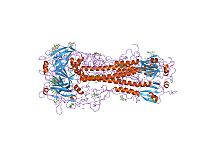
Photo from wikipedia
The high SARS-CoV-2 reproductive number driving the COVID-19 pandemic has been a mystery. Our recent in vitro, and in vivo coronaviral pathogenesis studies involving Mouse Hepatitis Virus (MHV-A59) suggest a… Click to show full abstract
The high SARS-CoV-2 reproductive number driving the COVID-19 pandemic has been a mystery. Our recent in vitro, and in vivo coronaviral pathogenesis studies involving Mouse Hepatitis Virus (MHV-A59) suggest a crucial role for a small host membrane-virus contact initiator region of the Spike protein, called the fusion peptide that enhances the virus fusogenicity and infectivity. Here we study the Spike from five human β-coronaviruses (HCoV) including the SARS-CoV-2, and MHV-A59 for comparison. The structural and dynamics analyses of the Spike show that its fusion loop spatially organizes three fusion peptides contiguous to each other to synergistically trigger the virus-host membrane fusion process. We propose a Contact Initiation Model based on the architecture of the Spike quaternary structure that explains the obligatory participation of the fusion loop in the initiation of the host membrane contact for the virus fusion process. Among all the HCoV Spikes in this study, SARS-CoV-2 has the most hydrophobic surface and the extent of hydrophobicity correlates with the reproductive number and infectivity of the other HCoV. Comparison between results from standard and replica exchange molecular dynamics reveal the unique physicochemical properties of the SARS-CoV-2 fusion peptides, accrued in part from the presence of consecutive prolines that impart backbone rigidity which aids the virus fusogenicity. The priming of the Spike by its cleavage and subsequent fusogenic conformational transition steered by the fusion loop may be critical for the SARS-CoV-2 spread. The importance of the fusion loop makes it an apt target for anti-virals and vaccine candidates.
Journal Title: Journal of Structural Biology
Year Published: 2021
Link to full text (if available)
Share on Social Media: Sign Up to like & get
recommendations!